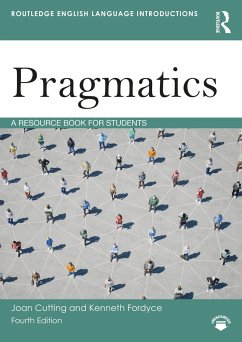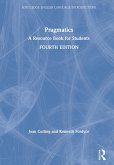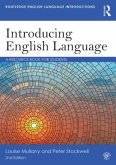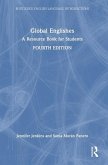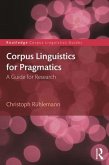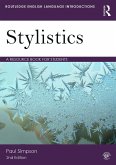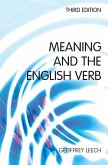- Broschiertes Buch
- Merkliste
- Auf die Merkliste
- Bewerten Bewerten
- Teilen
- Produkt teilen
- Produkterinnerung
- Produkterinnerung
Routledge English Language Introductions cover core areas of language study and are one-stop resources for students.
Andere Kunden interessierten sich auch für
![Pragmatics Pragmatics]() Joan CuttingPragmatics152,99 €
Joan CuttingPragmatics152,99 €![Introducing English Language Introducing English Language]() Louise Mullany (UK University of Nottingham)Introducing English Language39,99 €
Louise Mullany (UK University of Nottingham)Introducing English Language39,99 €![Global Englishes Global Englishes]() Jennifer JenkinsGlobal Englishes152,99 €
Jennifer JenkinsGlobal Englishes152,99 €![Global Englishes Global Englishes]() Jennifer JenkinsGlobal Englishes33,99 €
Jennifer JenkinsGlobal Englishes33,99 €![Corpus Linguistics for Pragmatics Corpus Linguistics for Pragmatics]() Christoph RühlemannCorpus Linguistics for Pragmatics40,99 €
Christoph RühlemannCorpus Linguistics for Pragmatics40,99 €![Stylistics Stylistics]() Paul Simpson (UK University of Liverpool)Stylistics59,99 €
Paul Simpson (UK University of Liverpool)Stylistics59,99 €![Meaning and the English Verb Meaning and the English Verb]() Geoffrey N. LeechMeaning and the English Verb52,99 €
Geoffrey N. LeechMeaning and the English Verb52,99 €-
-
-
Routledge English Language Introductions cover core areas of language study and are one-stop resources for students.
Hinweis: Dieser Artikel kann nur an eine deutsche Lieferadresse ausgeliefert werden.
Hinweis: Dieser Artikel kann nur an eine deutsche Lieferadresse ausgeliefert werden.
Produktdetails
- Produktdetails
- Routledge English Language Introductions
- Verlag: Taylor & Francis Ltd
- 4 ed
- Seitenzahl: 316
- Erscheinungstermin: 26. November 2020
- Englisch
- Abmessung: 246mm x 174mm x 17mm
- Gewicht: 568g
- ISBN-13: 9780367207250
- ISBN-10: 0367207257
- Artikelnr.: 60007641
- Herstellerkennzeichnung
- Libri GmbH
- Europaallee 1
- 36244 Bad Hersfeld
- gpsr@libri.de
- Routledge English Language Introductions
- Verlag: Taylor & Francis Ltd
- 4 ed
- Seitenzahl: 316
- Erscheinungstermin: 26. November 2020
- Englisch
- Abmessung: 246mm x 174mm x 17mm
- Gewicht: 568g
- ISBN-13: 9780367207250
- ISBN-10: 0367207257
- Artikelnr.: 60007641
- Herstellerkennzeichnung
- Libri GmbH
- Europaallee 1
- 36244 Bad Hersfeld
- gpsr@libri.de
Joan Cutting is a senior lecturer in TESOL at the University of Edinburgh. She studies intercultural pragmatics, vague language, and in-group codes. She is author of Analysing the Language of Discourse Communities (2000) and Language in Context in TESOL (2015), editor of Vague Language Explored (2007), and coeditor of the Edinburgh Textbooks in TESOL series (2013-2017). Kenneth Fordyce is a lecturer in TESOL at the University of Edinburgh. He previously worked as a language teacher in Austria and Japan. His research covers corpus linguistics, pragmatics, and intercultural pragmatics. He has a particular interest in post-truth discourse and the language of truth and lies in politics, the media, and health communication.
Contents cross-referenced
List of illustrations
Acknowledgements
A Introduction: concepts in pragmatics
1 Context and structure
2 Speech act theory
3 Cooperative principle
4 Politeness and impoliteness
5 Corpora and communities
6 Critical discourse analysis
7 Intercultural pragmatics
8 Pragmatics and language learning
B Development: studies in pragmatics
1 Analysing context
2 Using speech acts
3 Understanding implicature
4 Analysing politeness and impoliteness
5 Analysing markers
6 Detecting hidden values
7 Studying intercultural pragmatics
8 Teaching pragmatics
C Exploration: data for investigation
1 Contexts in writing
2 Culture and indirectness
3 Flouting and violating
4 Politeness and impoliteness
5 Variation and multimodal corpora
6 Language and power
7 Understanding each other
8 Pragmatics online and learning
D Extension: readings
1 Conversation analysis and ELF (Anita Santner-Wolfartsberger)
2 Speech acts and conversation analysis (J. César Félix-Brasdefer)
3 Relevance and emotion (Baiyao Zuo and Wen Yuana, Francis Y. Lin, and
Richard P. Cooper)
4 Impoliteness and rudeness (Jonathan Culpeper)
5 Corpora and language teaching (Lynne Flowerdew)
6 Multimodal critical discourse analysis (Steve Buckledee and David Machin)
7 African face needs (Karen Grainger, Sara Mills, and Mandla Sibanda)
8 Pragmatic development, ELF, and TBLT (Neil Murray and Marta
González-Lloret)
References
Index
List of illustrations
Acknowledgements
A Introduction: concepts in pragmatics
1 Context and structure
2 Speech act theory
3 Cooperative principle
4 Politeness and impoliteness
5 Corpora and communities
6 Critical discourse analysis
7 Intercultural pragmatics
8 Pragmatics and language learning
B Development: studies in pragmatics
1 Analysing context
2 Using speech acts
3 Understanding implicature
4 Analysing politeness and impoliteness
5 Analysing markers
6 Detecting hidden values
7 Studying intercultural pragmatics
8 Teaching pragmatics
C Exploration: data for investigation
1 Contexts in writing
2 Culture and indirectness
3 Flouting and violating
4 Politeness and impoliteness
5 Variation and multimodal corpora
6 Language and power
7 Understanding each other
8 Pragmatics online and learning
D Extension: readings
1 Conversation analysis and ELF (Anita Santner-Wolfartsberger)
2 Speech acts and conversation analysis (J. César Félix-Brasdefer)
3 Relevance and emotion (Baiyao Zuo and Wen Yuana, Francis Y. Lin, and
Richard P. Cooper)
4 Impoliteness and rudeness (Jonathan Culpeper)
5 Corpora and language teaching (Lynne Flowerdew)
6 Multimodal critical discourse analysis (Steve Buckledee and David Machin)
7 African face needs (Karen Grainger, Sara Mills, and Mandla Sibanda)
8 Pragmatic development, ELF, and TBLT (Neil Murray and Marta
González-Lloret)
References
Index
Contents cross-referenced
List of illustrations
Acknowledgements
A Introduction: concepts in pragmatics
1 Context and structure
2 Speech act theory
3 Cooperative principle
4 Politeness and impoliteness
5 Corpora and communities
6 Critical discourse analysis
7 Intercultural pragmatics
8 Pragmatics and language learning
B Development: studies in pragmatics
1 Analysing context
2 Using speech acts
3 Understanding implicature
4 Analysing politeness and impoliteness
5 Analysing markers
6 Detecting hidden values
7 Studying intercultural pragmatics
8 Teaching pragmatics
C Exploration: data for investigation
1 Contexts in writing
2 Culture and indirectness
3 Flouting and violating
4 Politeness and impoliteness
5 Variation and multimodal corpora
6 Language and power
7 Understanding each other
8 Pragmatics online and learning
D Extension: readings
1 Conversation analysis and ELF (Anita Santner-Wolfartsberger)
2 Speech acts and conversation analysis (J. César Félix-Brasdefer)
3 Relevance and emotion (Baiyao Zuo and Wen Yuana, Francis Y. Lin, and
Richard P. Cooper)
4 Impoliteness and rudeness (Jonathan Culpeper)
5 Corpora and language teaching (Lynne Flowerdew)
6 Multimodal critical discourse analysis (Steve Buckledee and David Machin)
7 African face needs (Karen Grainger, Sara Mills, and Mandla Sibanda)
8 Pragmatic development, ELF, and TBLT (Neil Murray and Marta
González-Lloret)
References
Index
List of illustrations
Acknowledgements
A Introduction: concepts in pragmatics
1 Context and structure
2 Speech act theory
3 Cooperative principle
4 Politeness and impoliteness
5 Corpora and communities
6 Critical discourse analysis
7 Intercultural pragmatics
8 Pragmatics and language learning
B Development: studies in pragmatics
1 Analysing context
2 Using speech acts
3 Understanding implicature
4 Analysing politeness and impoliteness
5 Analysing markers
6 Detecting hidden values
7 Studying intercultural pragmatics
8 Teaching pragmatics
C Exploration: data for investigation
1 Contexts in writing
2 Culture and indirectness
3 Flouting and violating
4 Politeness and impoliteness
5 Variation and multimodal corpora
6 Language and power
7 Understanding each other
8 Pragmatics online and learning
D Extension: readings
1 Conversation analysis and ELF (Anita Santner-Wolfartsberger)
2 Speech acts and conversation analysis (J. César Félix-Brasdefer)
3 Relevance and emotion (Baiyao Zuo and Wen Yuana, Francis Y. Lin, and
Richard P. Cooper)
4 Impoliteness and rudeness (Jonathan Culpeper)
5 Corpora and language teaching (Lynne Flowerdew)
6 Multimodal critical discourse analysis (Steve Buckledee and David Machin)
7 African face needs (Karen Grainger, Sara Mills, and Mandla Sibanda)
8 Pragmatic development, ELF, and TBLT (Neil Murray and Marta
González-Lloret)
References
Index

